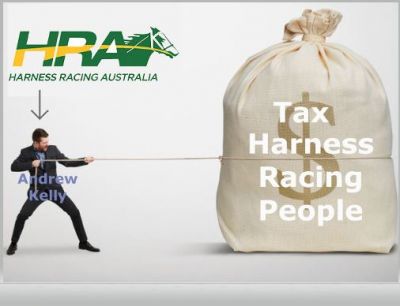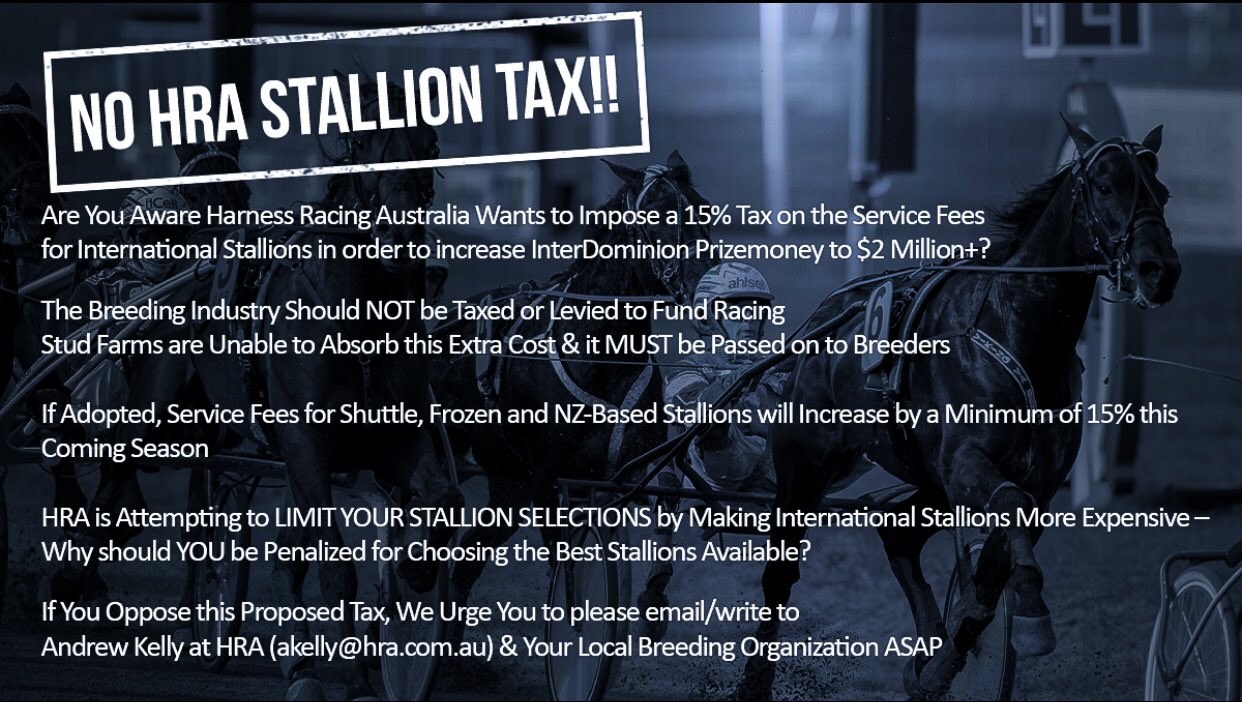One of Australasia’s leading media personalities recently penned an article claiming the ‘$2.1 million TAB Eureka is uniting Australian Harness Racing’.
It’s a great headline and created a compelling argument to do more than continue scrolling your phone or desktop.
How had Andrew Kelly and HRA united close to 1000 individuals who signed a petition in opposition to the HRA Stallion Levy? How had The Eureka helped the stallion owner and agistment/breeding farms doing it tough? Perhaps it had encouraged a wave of new breeders? Or better yet, inspired the hobby breeder of doing the impossible!
The opening stanza touched on the unification of stakeholders referenced in the headline with the following;
“Initially launched to some angst from sections of the breeding industry because its largely funded by stallion taxes, most knockers, doubters and critics have been silenced by the publicity the TAB Eureka has created and the way it’s strongly touched every harness racing jurisdiction in Australia.”
Interestingly, it’s one of the first public concessions by parties paid by HRA referring to the ‘Levy’ as a tax.
 To substantiate the claims made in the headline and commentary above, the author then listed the six states of Australia as subheadings before discussing the runners of which they each represent.
To substantiate the claims made in the headline and commentary above, the author then listed the six states of Australia as subheadings before discussing the runners of which they each represent.
Despite several attempts to find anything, there wasn’t any facts, figures or commentary from members of the breeding community which saw its number of stallion services reduced by almost 11% in the 22/23 breeding season. The same season the HRA levy was introduced.
Perhaps the fact that so many of them had simply walked away made it difficult to get a comment? Ignorance is bliss as they say.
It’s a bit tone-deaf in the current breeding environment for HRA to be paying media personalities completely unaffected by any decisions other than the ones to pay them, to simply gloss over very real problems as if they don’t exist.
An issue such as heavily reduced foal crops and breeders walking away is not something to be ignored. This is an industry reliant on producing a product for its funding which is rather ironic when you consider the sponsor of the slot race.
Nevertheless, the HRA-paid scribe expects us to believe that the geographical location of each runner in the slot race has unified Australian harness racing and silenced its critics?
By critics, I think the author is referring to concerned stakeholders, the ones whose formal submissions were ignored to the point they resort to more public forums to try and be heard. The ones whose livelihoods and passion for the sport are impacted by decisions that favour but a few. The ones with real skin in the game.
 Had the scribe done his research, he would have realised The Eureka and its half-million dollar advertising budget didn’t silence its ‘critics’, Harness Racing Australia did that 14 months ago with a press release to the industry on the 16th of June last year, where it states:
Had the scribe done his research, he would have realised The Eureka and its half-million dollar advertising budget didn’t silence its ‘critics’, Harness Racing Australia did that 14 months ago with a press release to the industry on the 16th of June last year, where it states:
“Registration (of a stallion) may be suspended or cancelled if the applicant or other persons connected with the horse engage in conduct that is detrimental or damaging to the industry or disparaging of HRA, its members, executive and staff.”
Stallion owners and anybody connected to them have been effectively muzzled. The above statement rendering them unable to publicly comment on concerns about the legality or legitimacy of the tax for fear of reprisal with huge ramifications.
Is this lawful? Probably not. But you get the feeling that powerbrokers are relying on anybody wanting to test the legalities of the levy/tax and how it is imposed and delivered, not having the financial resources to do so. Litigation costs and loss of potential revenue sources could be huge for playing with the proverbial fire.
Hoping an industry views you as more bark than bite is a bold strategy. But then again, so is spending a significant sum on an ex-New Zealand rugby league player to be the ambassador for a slot race which features only Australian-bred horses.
The whole romance around The Eureka being limited to Australian-bred three and four-year-olds is that it would stimulate the domestic breeding and yearling sales market. To date, it’s done neither.
How many reduced foal crops will it take HRA to realise this form of idealism is not the reality? Imports from New Zealand will only increase if the Australian domestic product shrinks. It doesn’t take an economist to understand basic supply and demand.
Furthermore, the eligibility ruling NZ Bred pacers out will always restrict this race to being the richest standardbred race in the world. But it will never be the greatest race in the world as we are led to believe. It’s a shame when you consider it could have been both.
Adding the likes of Merlin, Akuta, Don’t Stop Dreaming and Millwood Nike to a race void of depth could only have been a positive thing for the future of down under harness racing. A field like that would have been worthy of using the word unification given the two parties are stronger together, yet one jurisdiction seems hell-bent on refusing to accept this as fact. The belligerent nature of programming Australian age group and open class feature races on top of each other is ruining the trans-Tasman rivalry this industry needs to prosper. But we digress.
The muzzling of studs and stallion owners hasn’t stopped the chorus of negative sentiment from the ‘critics’ as the author claims.
You only need to type in ‘HRA Stallion Tax’ on your Twitter or ‘X’ search function to find examples of such. One participant points out that a prominent HRA Board member who happens to be a stallion owner served a nice increase of mares this season with the domiciled stallions he owns. The stallions who are largely unencumbered by the very levy he signed off on.
You will also find numerous examples of breeding participants reasoning with the wider harness racing community that they are far from anti the concept of delivering a slot race with stakes totalling $ 2.1 million in their backyard. In fact, the majority love the idea and it’s clear that the concept has significant potential . They are simply against the way it is being funded.
Surely having experienced a relative golden period of five years whereby breeding numbers had stabilised and grown, HRA could have looked at utilising or increasing other streams of revenue to make up the balance.
Breeders are doing it tough. It’s bloody easy to look at the high-priced yearling sales results of a select few and assume the contrary. However, look at the clearance rates at Australian sales in 2023 and you get a fairer reflection of where things currently sit.
Breeders already contribute significantly to funding racing with the costs of producing a foal from conception through to either the sales ring or on to the racetrack. They comprise the overwhelming majority of nomination and supplement payments to various futurity-type race series, all without guarantee of a return at the other end. You think the sport would be nurturing the front-line investment, not attempting to leech more from it!
It’s only a matter of time before futurity series are negatively impacted with the reduction in foal crops seeing reduced foal nomination payments and fewer funds in the overall prize pools.
Ignoring stakeholders and ploughing on with a concept that doesn’t grow anything other than the pockets of an already wealthy few is just about as naïve as implying the increased costs wouldn’t be passed onto the consumer.
Until somebody actually provides a metric of how many horses we need to sustain the harness racing industry, you can fairly assume that reduced foal crops will result in reduced racing and decreasing revenue for the industry. One slot race won’t change that.
Fewer horses mean fewer races and reduced field sizes. All metrics by which we know if are improved, or at a minimum, maintained, actually provide better betting races delivering increased turnover.
It’s not rocket science. We need more product! The 2022 Australian foal crop dipped below 3000 for only the second time on record.
Victoria was already coming off the back of a 23% decrease in the number of mares bred, now they have a $10,000,000 reduction in funding to consider.
If breeders continue to exit the industry due to mounting costs in an already perilous global economic environment, how is this uniting Australian Harness Racing as the author suggests?
Part of the attraction for the standardbred breeding sector is its ability to breed to the best modern bloodlines in the world thanks to artificial insemination. Looking at the locked-in slots for next month, all but two of the runners announced for the slot race are by North American stallions.
Future slot races won’t be much of a spectacle if we aren’t producing standardbreds competitive on the global stage.
When the major studs who already make a significant and overarching contribution to the industry with sponsorship dollars walk away because of reduced business making the importation of stallions an unfeasible business model, what then? If that money is so readily replaced, why aren’t you chasing those income streams instead of hindering your current ones?
The news that HRA are retrospectively invoicing the studs for horses bred in 2021, prior to the implementation of the stallion tax is another area that is beyond problematic. Breeders who bred in the 21/22 breeding season and lost a pregnancy, therefore getting a free return are having their services counted as part of the newly introduced stallion levy.
The communication informing the studs of this fact included a bullet point stating it’s up to them to determine whether to absorb the unbudgeted cost or pass it onto the breeder utilising a free return in good faith, which goes some way to summing up HRA’s attitude towards both parties.
It all smacks hugely of the fabled story of ‘The Goose That Lays The Golden Egg’. For revisionary history and those unfamiliar:
A man and his wife owned a goose which laid a golden egg every day. They considered themselves very lucky to possess such a rare bird, and they began to wonder just how much gold the goose must have inside it.
So they cut open the goose, killing it. However, to their disappointment, they discovered that the inside of the bird was like any other goose and was not made of gold. In killing the goose that laid the golden eggs, they had deprived themselves of a regular source of gold.
How much of that gold will continue to be poured into telling us the goose is alive and well?

 USA
USA Canada
Canada Australia
Australia New Zealand
New Zealand Europe
Europe UK / IRE
UK / IRE


